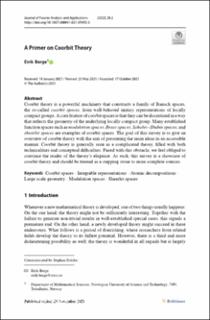A Primer on Coorbit Theory
Peer reviewed, Journal article
Published version
Permanent lenke
https://hdl.handle.net/11250/3024047Utgivelsesdato
2021Metadata
Vis full innførselSamlinger
- Institutt for matematiske fag [2474]
- Publikasjoner fra CRIStin - NTNU [38289]
Originalversjon
Journal of Fourier Analysis and Applications. 2021, 28 (1), 1-61. 10.1007/s00041-021-09892-5Sammendrag
Coorbit theory is a powerful machinery that constructs a family of Banach spaces, the so-called coorbit spaces, from well-behaved unitary representations of locally compact groups. A core feature of coorbit spaces is that they can be discretized in a way that reflects the geometry of the underlying locally compact group. Many established function spaces such as modulation spaces, Besov spaces, Sobolev–Shubin spaces, and shearlet spaces are examples of coorbit spaces. The goal of this survey is to give an overview of coorbit theory with the aim of presenting the main ideas in an accessible manner. Coorbit theory is generally seen as a complicated theory, filled with both technicalities and conceptual difficulties. Faced with this obstacle, we feel obliged to convince the reader of the theory’s elegance. As such, this survey is a showcase of coorbit theory and should be treated as a stepping stone to more complete sources.

